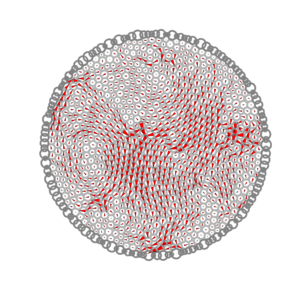Agent-based models offer a minimal approach to the study of the collective behavior of active particles — self-driven units, each capable of converting stored or ambient free energy into systematic motion. In such a setting, seminal studies of flocking as a phase transition were first carried out by Tamas Vicsek (but see also the remarkable computer-animation work of Craig Reynolds), with important modifications and extensions by many authors. The original Vicsek model describes point particles with fixed speed moving on an inert frictional substrate. The direction of motion changes according to a noisy local rule that requires particles to align with their neighbors at each time step. This family of models displays a well-defined transition from a disordered to an ordered phase with decreasing noise strength or increasing density. The emphasis of these studies so far has been mainly on order and fluctuations rather than forces and mechanics.
Our group has now started to use agent-based models to study the behavior of dense collections of active particles, in situations where steric effects and crowding are important. How do collections of active particles behave in very dense situations? What are the mechanical properties of the ensuing materials? The answers to these questions are fundamentally important for a wide range of physical and biological systems, from tissue formation and vibrated granular materials to the behavior of packed crowds.

Recent experiments on cell crawling in MDCK monolayers show velocity fields resembling granular soft modes that have been linked to glassy dynamics[1].
We have developed a minimal model of self-propelled polar disks[2] in a confined geometry which shares some of the characteristics outlined above[3].
We find both a solid ‘jammed’ phase as well as a liquid polar phase, depending on density and self-propulsion speed (see phase diagram plot). The solid phase is characterized by an oscillatory motion which couples to the soft modes of the packing, that is the lowest-energy elastic excitations (see snapshot).

For our model, we analytically derive a potentially generic mechanism in which all the energy introduced into the system through the self-propulsion cascades down to the lowest-energy mode. Then the resemblance between the tissue velocity fields and the soft modes is no coincidence, but stems from the fundamentally non-thermal energy input motility provides.
[1] T. E. Angelini, E. Hannezo, X. Trepat, M. Marquez, J. J. Fredberg, and D. A. Weitz, PNAS 108, 4714 (2011).
[2] B. Szabó, G. J. Szollosi, B. Gonci, Z. Juranyi, D. Selmeczi, and T. Vicsek, Phys. Rev. E 74, 061908 (2006).
[3] S. Henkes, Y. Fily and M. C. Marchetti, PRE(R) 84, 040301 (2011)
Publications related to this work:
S. Henkes, Y. Fily and M. C. Marchetti, Active jamming: Self-propelled soft particles at high density, PRE(R) 84, 040301 (2011)